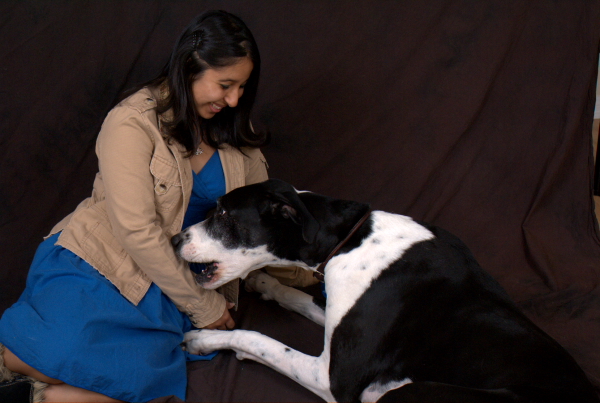I’m Dreaming of a White Christmas
December 25, 2008
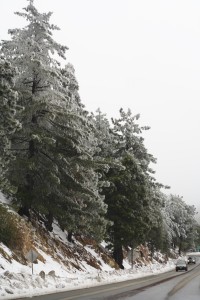 Every year Bryan and I try to see multiple family members during Christmas. We usually switch off who we go see on Christmas day. This year we went up to see Bryan’s mom and siblings in Crestline. Crestline is a mountain community just near Big Bear and Lake Arrowhead. As most of you Southern Californians know we recently had a big winter storm come through in the last week and that dumped a ton of snow in our mountains. We decided to drive up the afternoon of Christmas Eve, we heard another storm was coming through and we wanted to drive up before it got to us. On the drive up the weather was perfect but cold. We watched as our in car thermometer dropped as we went up the mountain; 50…45…38 degrees! That’s cold for us here in SoCal. The scenery was beautiful; snowy hilltops with snow flocked trees.
Every year Bryan and I try to see multiple family members during Christmas. We usually switch off who we go see on Christmas day. This year we went up to see Bryan’s mom and siblings in Crestline. Crestline is a mountain community just near Big Bear and Lake Arrowhead. As most of you Southern Californians know we recently had a big winter storm come through in the last week and that dumped a ton of snow in our mountains. We decided to drive up the afternoon of Christmas Eve, we heard another storm was coming through and we wanted to drive up before it got to us. On the drive up the weather was perfect but cold. We watched as our in car thermometer dropped as we went up the mountain; 50…45…38 degrees! That’s cold for us here in SoCal. The scenery was beautiful; snowy hilltops with snow flocked trees.
The already narrow mountain roads were made even narrower by the berms of snow created by the snow plows. When we got up to the house we were lucky to find the very steep driveway already dug out. It was a shock getting out of the car, I had three layers on and I was still freezing.
We were greeted by his mom’s dog Mimi upon our arrival, she didn’t seem to mind the cold. His mom was at work but all his siblings including his sisters, brother and his step dad were home keeping warm. While we waited for his mom to come home, Bryan decided to help by shoveling the snow off the driveway and deck. There was so much snow on the deck that Bryan made a little snowman. While Bryan was shoveling, his siblings and I sat by the fire and watched various Christmas movies. I also baked a red velvet cake for dessert. When Bryan’s mom came home from work we all ate a lovely dinner of spaghetti and let everybody open the presents that we brought up.
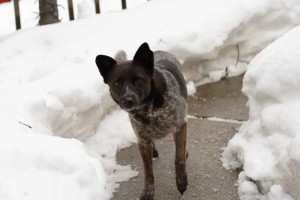
Mimi
 In the morning the kids opened all their presents and the living room was filled with wrapping paper and boxes. We sat around in our pajamas for a while partly because when we looked out the window it was raining pretty heavy and the wind was blowing fiercely. It was nice being inside next to a roaring fire, it was just like the song… “Oh the weather outside is frightful but the fire is so delightful, but since we’ve no place to go…let it snow, let it snow, let it snow!” But it wasn’t snowing, it was raining…hard.
In the morning the kids opened all their presents and the living room was filled with wrapping paper and boxes. We sat around in our pajamas for a while partly because when we looked out the window it was raining pretty heavy and the wind was blowing fiercely. It was nice being inside next to a roaring fire, it was just like the song… “Oh the weather outside is frightful but the fire is so delightful, but since we’ve no place to go…let it snow, let it snow, let it snow!” But it wasn’t snowing, it was raining…hard.  The trees looked like they would be blown over. We decided to leave before the weather got more frightful. The rain made the snow slushy and the roads into rivers. Once we got on the main highway to go down the mountain the fog was so dense we could hardly see a car length in front of us. We made it home safe though and will always have fond memories of our very own white Christmas.
The trees looked like they would be blown over. We decided to leave before the weather got more frightful. The rain made the snow slushy and the roads into rivers. Once we got on the main highway to go down the mountain the fog was so dense we could hardly see a car length in front of us. We made it home safe though and will always have fond memories of our very own white Christmas.
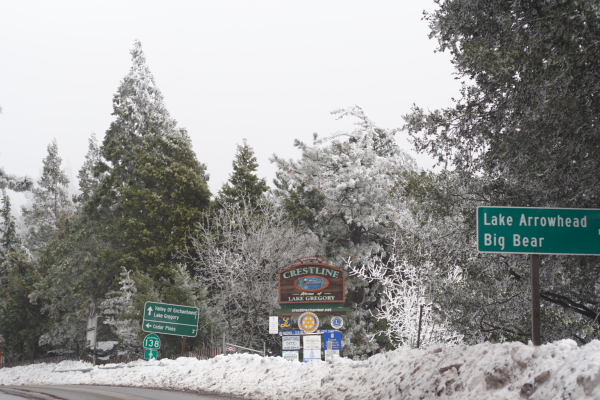
Hastings Ranch
December 23, 2008

 Five years ago Bryan and I went to see the Christmas lights at Hastings Ranch. I remember vaguely driving around this suburban neighborhood. What I do remember was Bryan telling me that we were close to the Arcadia Arboretum and that was where he wanted to propose to me. He didn’t, but I guess he couldn’t after telling me his plans, but more important to me was that he told me on that night that he wanted to marry me. At that point we had probably on
Five years ago Bryan and I went to see the Christmas lights at Hastings Ranch. I remember vaguely driving around this suburban neighborhood. What I do remember was Bryan telling me that we were close to the Arcadia Arboretum and that was where he wanted to propose to me. He didn’t, but I guess he couldn’t after telling me his plans, but more important to me was that he told me on that night that he wanted to marry me. At that point we had probably on ly been together for a couple of weeks. Later on that night we went to a small coffee shop called Bean Town and ordered white hot chocolates. It’s funny how the mind remembers those little details but that was a night I will never forget. Although I don’t remember the beauty of the Christmas lights, I do remember driving in the car with Bryan, listening to Vince Guaraldi’s Charlie Brown Christmas album. Now every time I see a Charlie Brown Christmas I remember that night when my future husband told me we would be together forever. Oh what a night…okay I’m done reminiscing now.
ly been together for a couple of weeks. Later on that night we went to a small coffee shop called Bean Town and ordered white hot chocolates. It’s funny how the mind remembers those little details but that was a night I will never forget. Although I don’t remember the beauty of the Christmas lights, I do remember driving in the car with Bryan, listening to Vince Guaraldi’s Charlie Brown Christmas album. Now every time I see a Charlie Brown Christmas I remember that night when my future husband told me we would be together forever. Oh what a night…okay I’m done reminiscing now.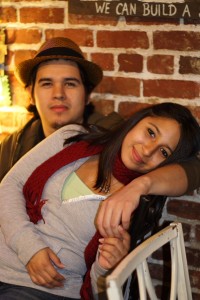
Claudia & Jimmy
I wanted to go back to that place again, partly because I didn’t remember the lights and partly because it had a special place in my heart. Hastings Ranch is a neighborhood in Sierra Madre, a city just next door to Pasadena. This time around I invited our friends Claudia and Jimmy. They were a little confused about why I wanted to drive so far to see Christmas lights, I knew they would never really understand. The community of  Hastings Ranch gets together every year and decorates each street based on themes. There are many different themes, from snowmen to Santa, stars to snowflakes. While there are many houses that decorate elaborately, the majority have very few decorations and some none at all. This is probably why I didn’t remember the lights. Also unlike other “Christmas light” neighborhoods I’ve been to, Hastings Ranch is meant to be driven. The other places we’ve been to are areas that you walk around, but this time we got to enjoy the Christmas lights by car. It was much warmer that way.
Hastings Ranch gets together every year and decorates each street based on themes. There are many different themes, from snowmen to Santa, stars to snowflakes. While there are many houses that decorate elaborately, the majority have very few decorations and some none at all. This is probably why I didn’t remember the lights. Also unlike other “Christmas light” neighborhoods I’ve been to, Hastings Ranch is meant to be driven. The other places we’ve been to are areas that you walk around, but this time we got to enjoy the Christmas lights by car. It was much warmer that way.

Zone Systems
December 15, 2008

Red Rock Canyon by Bryan
Last Thursday Bryan and I finished our last class of the Fall semester; Zone Systems. This class was taught by Greg Rager who is an expert in the old processes of photography. The zone system is not easily explained but I will make an attempt to make sense out of it. Basically it only applies to black & white photography. This class is completely film based and although Rager would have preferred having the class using medium format cameras that simply was not feasible so we used 35mm. There are eleven zones in black & white photography ranging from Zone 0 to Zone 10. It ranges from white to black, however there is no such thing as white and black it is only shades of gray. So basically it ranges from really light gray to really dark gray. Zone 5 represents 18% gray, which is what your camera meter reads…you following me so far? The purpose of zone systems is to eventually make a good print, but in order to make a good print you have to know how to make a good negative and of course in order to get a good negative you have to know how to expose for the different zones of detail when taking the photograph.

Red Rock Canyon by Jamie
The zone system works best on landscapes or any seen where there is not a lot of movement. It’s all about getting details in the shadows and also in the highlights. Rager recommends using a spot light meter when photographing because you can get readings for the different zones and try to find a happy medium. You should probably make sure your camera’s shutter and light meter are working before photographing as that can make a huge impact on your photo. Rager actually had some people do shutter speed testing on their cameras to see what actual speed their shutters were firing at. Some peoples cameras were way off. Unfortunately I didn’t get a chance to do this because I ran out of time, although I should have because my Pentax 35mm is ancient. Bryan didn’t have this problem as he has a newer A2E.

Red Rock Canyon by Bryan
After taking a whole roll of film we were expected to develop it ourselves and while most people did this we chose not to. There is a lot of work that goes into exposing a roll of film, like making sure your chemistry isn’t bad, the temp of the chemicals is not too hot or too cold and agitating properly. Now because Bryan and I work full time and have a very hard time staying up really late we decided to go the easy route and have our film developed at Pro Photo Connection. Rager was fine with us doing this however, he did have some concerns about how they might develop the film. Because there are so many factors that go into making a good print the developing process could easily be screwed up if someone at the lab doesn’t do something as simple as agitate for a long enough time. Many people in the class screwed up and had to develop multiple rolls of film. We just didn’t have that kind of time.

Irvine Regional Park by Jamie
A rule that Rager taught us was to expose for the shadows and develop for the highlights. You always want to make sure you capture the details in the shadows. You never want your negative to be too thin. A thin negative means you have not exposed enough and that will translate to a low contrast print. Likewise you never want your negative to be too dense. A dense negative means you overexposed and your print will be too light. If your negative isn’t at the extreme on either side of the spectrum it can be corrected in the printing process with dodging and/or burning. Dodging a negative simply means you are subtracting light when exposing the image to the photo paper. For example, if you have a print that needs 10 seconds of light exposure but a certain area is too thin and needs less exposure so you can get details in the shadows. You would simply set your timer for 10 seconds and let it expose the whole print for a few seconds and then cover up the thin area with some kind of apparatus for the rest of the time so it won’t get as much light. Burning is just the opposite, if you have an area that is too dense and needs more light you would then expose the whole print for whatever time is best for the normal areas of the print then cover those up and expose the dense areas to more light to get more details in the highlights. Does this sound like too much work? Well it is! That’s why it is so important to get the negative right in the camera. The better the negative is the easier it is to work with in the darkroom. In one instance Bryan went through a whole pack of photo paper and spent 4 hours to get one good print.
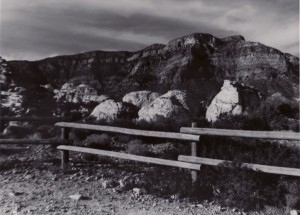
Red Rock Canyon by Jamie
At the end of the class we had to present a portfolio of six prints to the class. You would think six prints sounds like a small amount for a portfolio until you realize how time consuming and frustrating it is to get one good print. I definitely learned a lot from this class but I think that the difficulty of the class requires more time then just 16 weeks. It took a long time for people in the class to get good negatives, it seemed like there was more experimentation in the dark room than actually shooting the film. I heard that the college is thinking about turning the class into a four part series and that probably is a better idea because there is no way you can learn everything about the zone system in one course, no matter how good the instructor is. I have to give credit to Rager though, he was very patient with us, even when we asked the same questions over and over and over again. I’m sure he’s used to the confusion.
Portrait Photography Class
December 10, 2008
Last night was our final meeting for our Portrait Photography class. We had taken two classes this semester, both ran from 5pm -10pm, with the portrait class meeting on Tuesday’s and our other class meeting on Thursday. Bryan and I both work full time as well as shoot triathlons, so taking these classes really exhausted us. However, I think we learned a lot from both of these classes. I now would like to take a moment to do an overview of our portrait class. This class was taught by Michael Lanoue who we had before in our beginning photo class. He gave us a total of four shooting assignments; environmental portrait, natural light portrait, synchro sun and glamour portrait with a portfolio of work due at the end of the semester.









